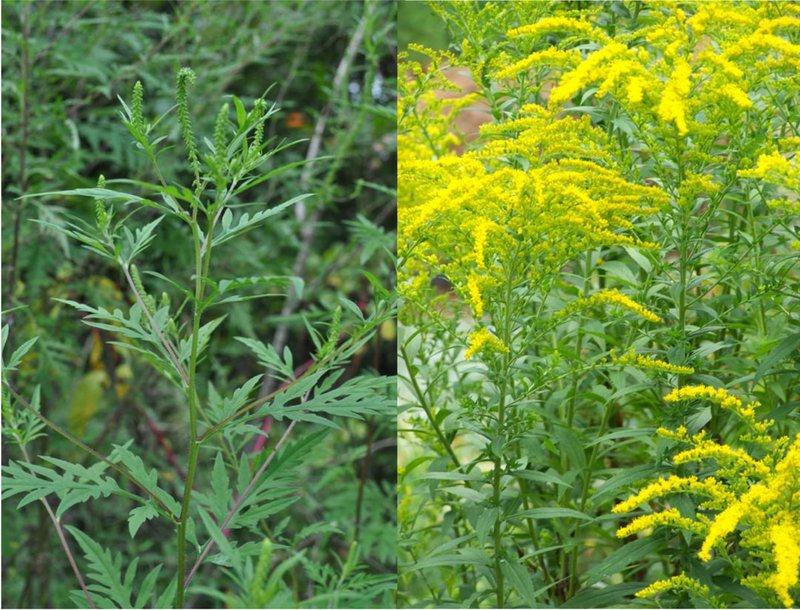Back to September 2015 Newsletter
Ragweed is the Allergy Offender

Kim Fellows
Goldenrod (Solidago species) and ragweed (Ambrosia species) are both members of the aster family, Asteraceae, and both begin to flower in late summer. They both have a similar flower head structure, bearing composite flowers, typical of the Aster family.
One difference between these plants is their flower colour. Goldenrod's bloom looks just like it sounds – bright glinting gold that fades to papery brown. Ragweed's flowers are smaller and plainer, and are a much less noticeable greenish-yellow colour. The two plants bear leaves that are different too. If you'd like to explore these differences, a master gardener shows you the differences in this 2-minute video.
The other important difference between these two family members lies in the way they are pollinated. Plants like goldenrod have heavy, sticky pollen that needs to be moved by animals – mostly insects, especially native bees. Plants like ragweed, on the other hand, have lightweight pollen that can travel with wind currents. Because wind-pollinated plants rely on air travel, they make great quantities of pollen, much of which is wasted. Inevitably, the summer air is full of ragweed pollen, which tickles the noses and eyes of those affected by allergies. You can see some of these differences in this great comic by Rosemary Mosco.
Once you notice goldenrod buds opening later in the summer, you will also notice a lot of insects around it. I am referring to both the number of insects, and kinds of insects: soldier beetles, wasps, bees, flies, ladybugs and ants all visit goldenrod, reminding us of its importance not just for pollinators, but also for general insect diversity. We allowed goldenrod to flourish in Pollination Canada's summer Pollinator Fedge project this year, and we were very pleased to see the diversity of insects it attracted.
However, I don't want to leave you with the erroneous impression that ragweed has no value, for all plants, like all animals, have a purpose. As ecological gardener JP Lamarche notes in his book, Common Sense Ecolution, ragweed "may actually be valuable around peach orchards and strawberry fields, because it can act as an alternative host to pests. Ragweed also provides food for over 60 species of birds."
**
Kim Fellows is coordinator of Pollination Canada.
Photo above: The deeply lobed leaves of ragweed (shown left), purplish stems, and inconspicuous green flowers help distinguish it from the goldenrod (shown right), which has unlobed leaves and bright, showy, golden flower plumes. Credit: Alicia Lamborn. University of Florida, The Institute of Food and Agricultural Sciences (IFAS) Extension Services.
Not yet a member?
An annual membership to Seeds of Diversity gives you access to our seed exchange, seed grow-out programs, and our online news.

We depend on donations to do our work.

Thank you for your support!
